Our final project and lesson with these students. In this lesson we chose to teach about community projects, and how artists can work together to make larger pieces of work. We encouraged each student to create art around their favorite things. You can read more about this experience in our blog.
Service Learning Lesson Plan 5
Title: Collaboration and Community
Group/Date: 04/18
Community Connections Kellyn, Erica and Crystal
____________________________________________________________
Lesson Idea and Relevance: What are you going to teach and why is this lesson of importance to your students? How is it relevant to students of this age and background?
_____________________________________________________________
______________________________________________________________
______________________________________________________________
Essential Understanding (s): What are the “big ideas”? What specific understandings about them are desired?
______________________________________________________________
_______________________________________________________
Essential Question (s): What provocative questions will foster inquiry, understanding, and transfer of learning?
_______________________________________________________
______________________________________________________________
______________________________________________________________Outcomes - Students will be able to...What key knowledge and skills will students acquire as a result of this unit? ...Art history and culture; expressive features and characteristics of art; art materials, tools, and techniques? What should they eventually be able to do as a result of such knowledge and skill? ...Compare and contrast art work; analyze sketches?
Students will be able to:
_______________________________________________________
______________________________________________________________
______________________________________________________________
Student Reflective Activity: Through what authentic performance task(s) will students demonstrate the desired understandings? How will students reflect upon and self-assess their learning?
______________________________________________________________
______________________________________________________________
______________________________________________________________
Assessment Instrument (s): By what criteria will “performances of understanding” be judged?
______________________________________________________________
Good:
Getting it:
Not Getting it:
______________________________________________________________
______________________________________________________________
Pre-assessment: How will you help the students know where the unit is going and what is expected? Help the teacher know where the students are coming from (prior knowledge, interests)?
______________________________________________________________
______________________________________________________________
______________________________________________________________
Motivation: How will you hook all students and hold their interest?
______________________________________________________________
______________________________________________________________
Ideation: How will you equip students, help them experience the key ideas, and explore the issues to generate ideas for their art work?
______________________________________________________________
______________________________________________________________
Procedures: How is the lesson organized to maximize initial and sustained engagement as well as effective learning? Provide opportunities to rethink and revise their understandings and work? Allow students to evaluate their work and its implications? Include literacy and numeracy?
______________________________________________________________
8. Clean up will take place before the gallery walk. Clean up will happen minutes prior to end of class to allow plenty of time for gallery walk and brief closing conversations. Also, all previous art work must be made available for students to claim.
Approximate timeline for class period:
12:3012:35 greeting and seating
12:36 12:40 assignment introduction
12:411:30 work on triangles
1:311:40 clean up spaces and materials
1:411:59 triangle placement and gallery walk, photos.
2:00 dismissal
Questions to consider during class:
Who is in your community? (personal relationships)
What kinds of things would you find in your community? (Place and identity)
What types of activities do you do in your community? (action and development)
Where could you help people in your community? (contribution and collaboration)
How does that color communicate your intent? (communication)
Additional Notes:
a. Community project: Class puzzle. Today we are going to create a collaborative puzzle. One idea of community is that every individual has something to contribute to a larger group of people with similar interests or needs. We would like for you to translate your idea of community into a visual representation. Think of how the people in your life that help you, or you help affect your daily lives and how that makes you feel. The way it works is everyone does their own work on each of these triangles, when you are finished we fit all of your individual pieces together to create a whole work of art. Just like a community we each have our own vision to contribute and when we work together we
create something wholly diverse and inclusive. We are also creating something that has unity. You may choose what materials you would like to use on your triangle. We ask that you consider your composition and try to use the entire space. We have enough triangles for everyone to do at least two. When you are finished, we would like you to find a spot in the puzzle to place your piece where it fits.
b. There will be a large layout of the puzzle so that students can figure out how to rotate or move their piece to make it fit.
Around 1:30 we will have students who are still working, make finishing marks and bring their triangle(s) to the puzzle frame for placement. Students may work with paras or teachers for placement of triangle if necessary.
Once every triangle has been placed the students will view and comment where possible. Photos will be taken of whole group and the completed puzzle.
The lesson will be concluded at this point and students will be dismissed.
______________________________________________________________
______________________________________________________________
Materials and Resources: What is needed to complete the learning plan? List materials and resources in a bullet-ed format.
______________________________________________________________
______________________________________________________________
______________________________________________________________
Preparation and Safety: What do you need to prepare for this experience? What safety issues need to be addressed? List steps of preparation and safety in a bullet-ed format.
______________________________________________________________
______________________________________________________________
Accommodations: How is the lesson tailored (personalized) to the different needs, interests, and abilities of learners? ...Access (Resources and/or Process) and Expression (Products and/or Performance)?
______________________________________________________________
1. Elli needs to be able to sit in a chair instead of a stool if she needs. She will have a table set up next to the art tables.
2. Shelby will be monitored for continued interest. She has a short attention span.
3. All non verbal communicators will be shown the techniques through hand-over-hand demonstration.
4. Employ certain participants to assist in demonstrations, through their own activity.
______________________________________________________________
______________________________________________________________
__________________________________________
Title: Collaboration and Community
Group/Date: 04/18
Community Connections Kellyn, Erica and Crystal
____________________________________________________________
Lesson Idea and Relevance: What are you going to teach and why is this lesson of importance to your students? How is it relevant to students of this age and background?
_____________________________________________________________
- Teachers will use a completing a group puzzle to teach about the concept of unity.
- This lesson will help foster reasoning related to geometric shapes as well as allow students to contribute to a group project and collaborate with their classmates.
______________________________________________________________
______________________________________________________________
Essential Understanding (s): What are the “big ideas”? What specific understandings about them are desired?
______________________________________________________________
- Artists can work collaboratively with other artists to make large pieces of community driven work.
_______________________________________________________
Essential Question (s): What provocative questions will foster inquiry, understanding, and transfer of learning?
_______________________________________________________
- How do artists use pieces of a whole or individual geometric shapes to create artwork?
- How can artists work with other artists to create artwork that is unified?
______________________________________________________________
______________________________________________________________Outcomes - Students will be able to...What key knowledge and skills will students acquire as a result of this unit? ...Art history and culture; expressive features and characteristics of art; art materials, tools, and techniques? What should they eventually be able to do as a result of such knowledge and skill? ...Compare and contrast art work; analyze sketches?
Students will be able to:
_______________________________________________________
- Students will be able to demonstrate geometric reasoning through placement of their puzzle piece in the puzzle frame.
- Students will problem solveto complete a whole work of art.
- Students will compare and contrast how the individual pieces make up the whole work,they will analyze the aesthetic effect of the whole for the best fit of the individual components.
- Students will create "an art component" using known and unknown materials, color, and shape to express content.
______________________________________________________________
______________________________________________________________
Student Reflective Activity: Through what authentic performance task(s) will students demonstrate the desired understandings? How will students reflect upon and self-assess their learning?
______________________________________________________________
- Students will reflect on their work in progress through personal and external inquiry.
- Students will engage in a gallery walk to view and respond to the finished collaborative piece.
______________________________________________________________
______________________________________________________________
Assessment Instrument (s): By what criteria will “performances of understanding” be judged?
______________________________________________________________
- Students will demonstrate through collaboration with their peers, and creation of parts of a whole; the meaning of community.
- Students will demonstrate critical thinking through placement of their piece of the puzzle to complete the whole.
Good:
Getting it:
Not Getting it:
______________________________________________________________
______________________________________________________________
Pre-assessment: How will you help the students know where the unit is going and what is expected? Help the teacher know where the students are coming from (prior knowledge, interests)?
______________________________________________________________
- Teachers will inquire about prior knowledge and familiarity with local/public/collaborative art.
- “What is teamwork?”
- “How can artists use teamwork to make unified art?”
- “Are you familiar with public art?"
- "What about community driven art projects?”
______________________________________________________________
______________________________________________________________
Motivation: How will you hook all students and hold their interest?
______________________________________________________________
- Teachers will share example works of community projects to students to connect personal experiences.
- Teachers will ask questions like, “Have you seen a large scale artwork in your community?” “How many people do you think worked on it?” “Have you ever worked with other people to create a work of art?”
- Teachers will also get an idea about students’ knowledge of geometric reasoning by asking questions like,“Who here has ever put a puzzle together?” Or, if I turn this puzzle piece like this, will it fit together with the other pieces?”
- Teachers will gauge reactions of recognition of students and their personal experiences shared with class.
______________________________________________________________
Ideation: How will you equip students, help them experience the key ideas, and explore the issues to generate ideas for their art work?
______________________________________________________________
- The lesson will focus on the students’ own personal interests along with community collaboration. Students will be shown examples of the end result to give them an idea of the goal: Collaborative and unified art.
- “We have looked at some community projects created by X, Y, and Z communities what images does it bring to mind for your own project?”
- “What does community mean to you?”
- Some artists use color to convey
emotion, what emotions do you experience when you think of your community? What colors would you use to show that?
______________________________________________________________
Procedures: How is the lesson organized to maximize initial and sustained engagement as well as effective learning? Provide opportunities to rethink and revise their understandings and work? Allow students to evaluate their work and its implications? Include literacy and numeracy?
______________________________________________________________
- Welcome students back to class. Offer name tags if they wish to create them.
- Crystal will Briefly review what we did last class and compare to today’s lesson
- Kellyn will show an example of a collaborative piece, and make the connection between the art and community. These artists are individuals working together to create a diverse work that represents the community.
- Ex:“ThisartworkbycreatedbyArtistFranciscoAlvaradoJuárezandfivelocalorganizations
(shown at the Hamilton building: Denver Art Museum) joined 5 dynamically shaped panels to create a cohesive piece. Each panel has a unique representation about the environment.- Can ask things like, “what kinds of different things can you see in this piece of art? Do each of the pieces look different or the same to you? Is this one piece of art or is it more than one pieces of art?” And then can say something like, “each panel is different because a different organization created each one. Yet they put all of the pieces together to create one piece of art.”
- Ex: Fort Collins Mural Project artwork brings art to public spaces. Can ask things like, “What do you think the goal of the project is?” (One goal is to beautify the city and enrich the culture and community.)
- Erica and Crystal will help to hold up examples and bring them closer to the groups so that they can directly engage with them.
- Erica will review the materials that we have used so far and any new materials briefly, Kellyn and Crystal will assist.
- We will briefly demonstrate watercolor use and compare the similarities and differences to acrylic painting.
- Pass around sample sheets of the difference between marker, colored pencil, pastels, crayons and watercolor pencils. (Review.)
- Crystal will introduce the lesson. Kellyn and Erica will pass out materials and get students prepared to participate
8. Clean up will take place before the gallery walk. Clean up will happen minutes prior to end of class to allow plenty of time for gallery walk and brief closing conversations. Also, all previous art work must be made available for students to claim.
Approximate timeline for class period:
12:3012:35 greeting and seating
12:36 12:40 assignment introduction
12:411:30 work on triangles
1:311:40 clean up spaces and materials
1:411:59 triangle placement and gallery walk, photos.
2:00 dismissal
Questions to consider during class:
Who is in your community? (personal relationships)
What kinds of things would you find in your community? (Place and identity)
What types of activities do you do in your community? (action and development)
Where could you help people in your community? (contribution and collaboration)
How does that color communicate your intent? (communication)
Additional Notes:
a. Community project: Class puzzle. Today we are going to create a collaborative puzzle. One idea of community is that every individual has something to contribute to a larger group of people with similar interests or needs. We would like for you to translate your idea of community into a visual representation. Think of how the people in your life that help you, or you help affect your daily lives and how that makes you feel. The way it works is everyone does their own work on each of these triangles, when you are finished we fit all of your individual pieces together to create a whole work of art. Just like a community we each have our own vision to contribute and when we work together we
create something wholly diverse and inclusive. We are also creating something that has unity. You may choose what materials you would like to use on your triangle. We ask that you consider your composition and try to use the entire space. We have enough triangles for everyone to do at least two. When you are finished, we would like you to find a spot in the puzzle to place your piece where it fits.
b. There will be a large layout of the puzzle so that students can figure out how to rotate or move their piece to make it fit.
Around 1:30 we will have students who are still working, make finishing marks and bring their triangle(s) to the puzzle frame for placement. Students may work with paras or teachers for placement of triangle if necessary.
Once every triangle has been placed the students will view and comment where possible. Photos will be taken of whole group and the completed puzzle.
The lesson will be concluded at this point and students will be dismissed.
______________________________________________________________
______________________________________________________________
Materials and Resources: What is needed to complete the learning plan? List materials and resources in a bullet-ed format.
______________________________________________________________
- Large piece of cardboard
- Scissors
- White paper
- Markers
- Paint
- Paintbrushes
- Watercolor paints
- Tissue paper
- Watereddown glue
- Oil pastels
- Precut Triangles
- Pencils and erasers
______________________________________________________________
______________________________________________________________
Preparation and Safety: What do you need to prepare for this experience? What safety issues need to be addressed? List steps of preparation and safety in a bullet-ed format.
______________________________________________________________
- Assemble materials
- Monitor safe usage of tools
- Assemble puzzle backing and mark outlines
- Prep for any accommodations
______________________________________________________________
Accommodations: How is the lesson tailored (personalized) to the different needs, interests, and abilities of learners? ...Access (Resources and/or Process) and Expression (Products and/or Performance)?
______________________________________________________________
1. Elli needs to be able to sit in a chair instead of a stool if she needs. She will have a table set up next to the art tables.
2. Shelby will be monitored for continued interest. She has a short attention span.
3. All non verbal communicators will be shown the techniques through hand-over-hand demonstration.
4. Employ certain participants to assist in demonstrations, through their own activity.
______________________________________________________________
______________________________________________________________
__________________________________________
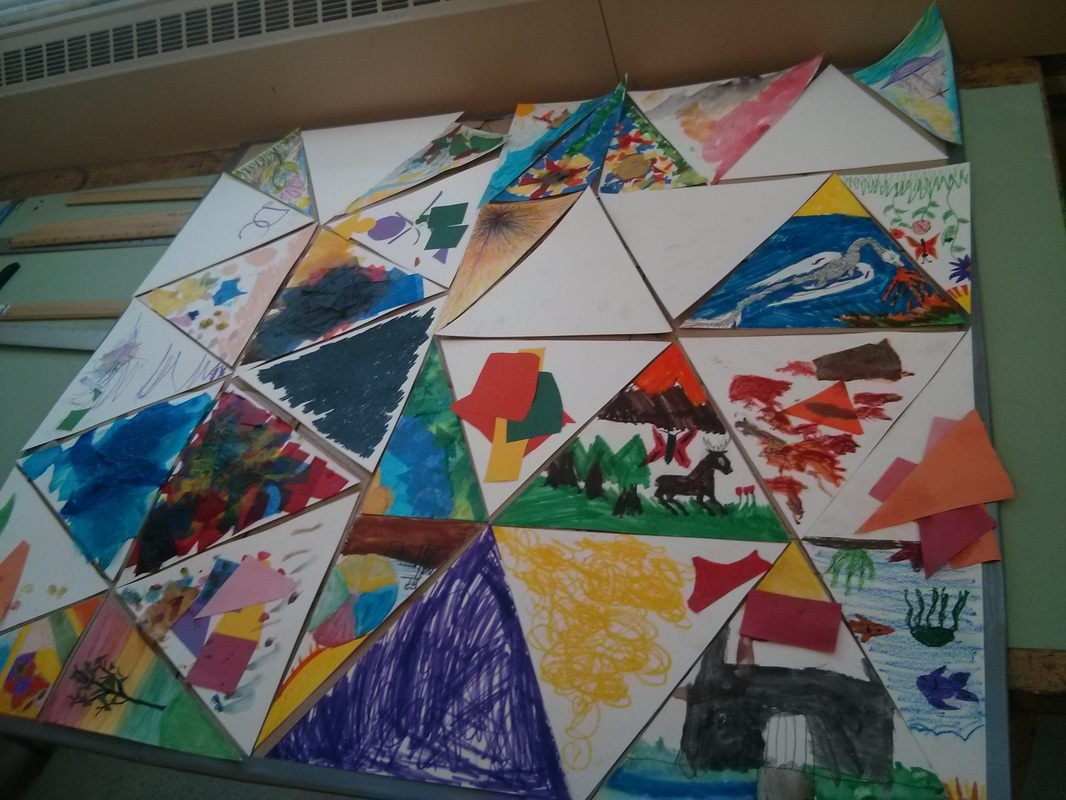
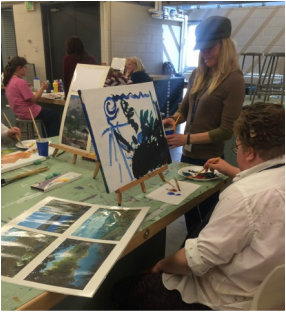
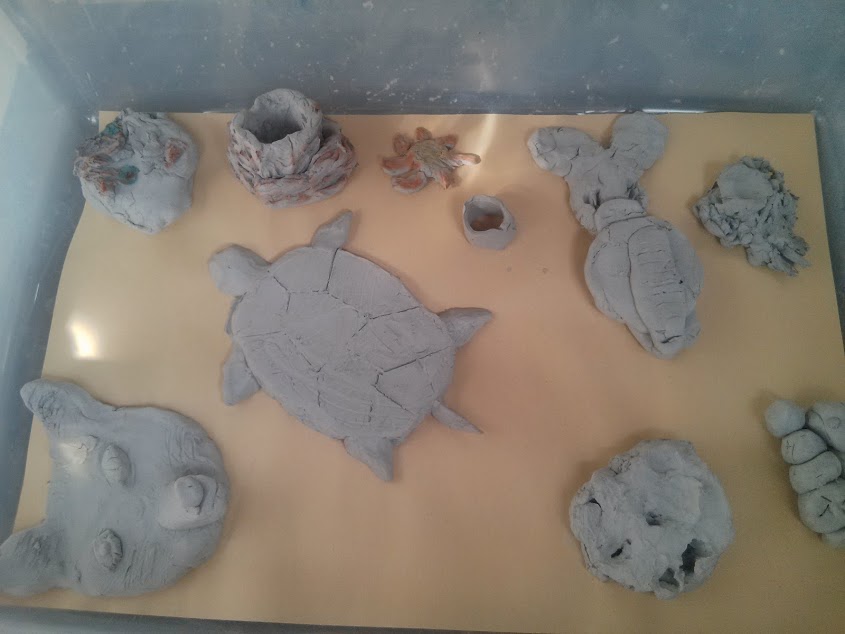
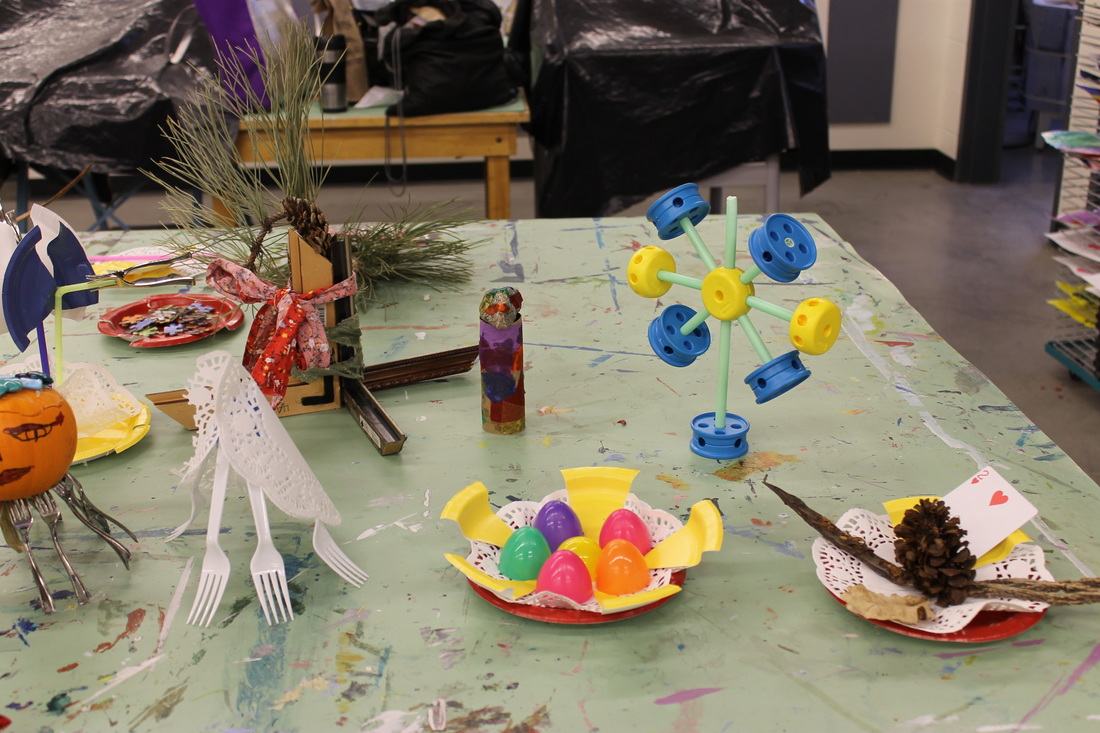
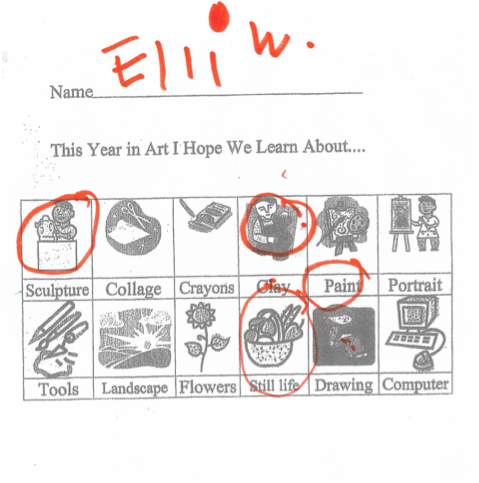
 RSS Feed
RSS Feed
